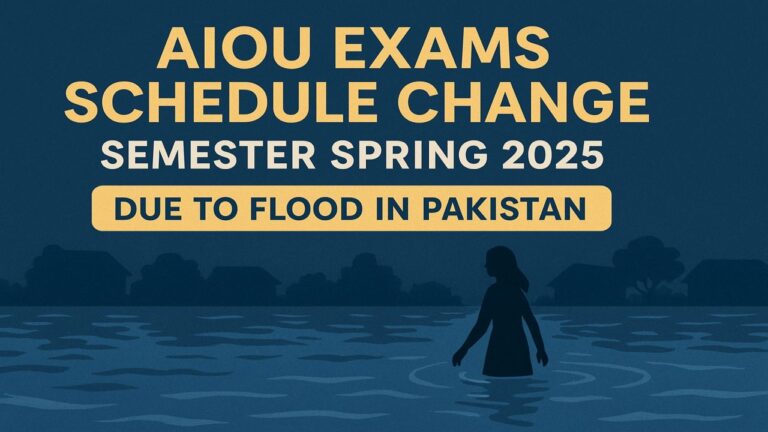1424 Code Solved Paper Spring 2023 – Compulsory English-II
The 1424 Code Solved Paper Spring 2023 is specially prepared for BA/BS students enrolled in Compulsory English-II at AIOU. This solved paper includes complete and accurate answers to help students grasp important topics covered during the semester. It follows the official exam structure and provides guidance on how to effectively attempt each question. The 1424 Code Solved Paper Spring 2023 is a useful resource for practicing comprehension, grammar, and writing sections in a clear and organized manner. It is ideal for last-minute preparation for upcoming exam and focused study sessions.
| Level | BA/BS |
|---|---|
| Semester | Spring 2023 |
| Subject/Course Code | Compulsory English-II (1424) |
| Maximum Marks | 100 |
| Pass Marks | 50 |
| Medium of Instruction | Compulsory English |
| ATTEMPT All QUESTIONS | |
1424 Code Past Paper Spring 2023 – Compulsory English-II

AIOU 1424 Code Solved Paper Spring 2023
Question 1:
Write an argumentative essay of not more than 300 words on “Disadvantages of Social Media”. (10 Marks)
Write an argumentative essay of not more than 300 words on “Disadvantages of Social Media”. (10 Marks)
Answer:
In today’s digital era, social media has become an essential part of our daily lives. While it offers various benefits such as communication, entertainment, and information sharing, the disadvantages of social media cannot be overlooked. Social media has contributed to multiple social and psychological problems, especially among the youth.
Firstly, social media has led to an increase in mental health issues. Constant comparison with others, cyberbullying, and the pressure to maintain a perfect online image often cause anxiety, depression, and low self-esteem. Studies have shown that people who spend more time on social platforms tend to feel more isolated and unhappy.
Secondly, social media can be a major source of distraction. Students and professionals waste valuable hours scrolling through feeds instead of focusing on their studies or work. This leads to decreased productivity and poor performance.
Moreover, social media is a hub for misinformation. Fake news and unverified content spread rapidly, leading to confusion, panic, or even harm in some cases. It is difficult to control what is shared, and this often results in the manipulation of public opinion.
Lastly, privacy is at risk on social media. Personal data can be accessed, misused, or stolen, putting users at serious risk of identity theft or cybercrimes.
In conclusion, although social media has revolutionized the way we connect, its negative impacts on mental health, productivity, information accuracy, and privacy are concerning. Users must be cautious and responsible in how they use these platforms to avoid falling into its many traps.
In today’s digital era, social media has become an essential part of our daily lives. While it offers various benefits such as communication, entertainment, and information sharing, the disadvantages of social media cannot be overlooked. Social media has contributed to multiple social and psychological problems, especially among the youth.
Firstly, social media has led to an increase in mental health issues. Constant comparison with others, cyberbullying, and the pressure to maintain a perfect online image often cause anxiety, depression, and low self-esteem. Studies have shown that people who spend more time on social platforms tend to feel more isolated and unhappy.
Secondly, social media can be a major source of distraction. Students and professionals waste valuable hours scrolling through feeds instead of focusing on their studies or work. This leads to decreased productivity and poor performance.
Moreover, social media is a hub for misinformation. Fake news and unverified content spread rapidly, leading to confusion, panic, or even harm in some cases. It is difficult to control what is shared, and this often results in the manipulation of public opinion.
Lastly, privacy is at risk on social media. Personal data can be accessed, misused, or stolen, putting users at serious risk of identity theft or cybercrimes.
In conclusion, although social media has revolutionized the way we connect, its negative impacts on mental health, productivity, information accuracy, and privacy are concerning. Users must be cautious and responsible in how they use these platforms to avoid falling into its many traps.
Question 2:
Write a brief note about “A Day in a Student’s Life” using appropriate sequence markers such as First, Next, Then, Later, Meanwhile, Subsequently, Finally, etc. (10 Marks)
Write a brief note about “A Day in a Student’s Life” using appropriate sequence markers such as First, Next, Then, Later, Meanwhile, Subsequently, Finally, etc. (10 Marks)
Answer:
A day in a student’s life is usually packed with various activities and responsibilities. First, the student wakes up early in the morning to get ready for school. Next, they have a quick breakfast and leave for their classes. Then, the student attends multiple lectures, listens attentively, and takes notes.
Later, during the break, the student socializes with friends and refreshes for the remaining classes. Meanwhile, they might also visit the library or complete pending assignments. Subsequently, once the school day ends, the student returns home and takes some rest.
Then, they begin working on their homework or study for upcoming tests. Later, they might take some time to watch TV or use social media for entertainment. Finally, after having dinner with the family, the student prepares for the next day and goes to bed early to stay fresh and active.
This daily routine reflects how a student balances academic tasks, relaxation, and social time with effective time management and dedication.
A day in a student’s life is usually packed with various activities and responsibilities. First, the student wakes up early in the morning to get ready for school. Next, they have a quick breakfast and leave for their classes. Then, the student attends multiple lectures, listens attentively, and takes notes.
Later, during the break, the student socializes with friends and refreshes for the remaining classes. Meanwhile, they might also visit the library or complete pending assignments. Subsequently, once the school day ends, the student returns home and takes some rest.
Then, they begin working on their homework or study for upcoming tests. Later, they might take some time to watch TV or use social media for entertainment. Finally, after having dinner with the family, the student prepares for the next day and goes to bed early to stay fresh and active.
This daily routine reflects how a student balances academic tasks, relaxation, and social time with effective time management and dedication.
Question 3:
Write a classification essay of not more than 250 words about “Books”, categorizing them into different kinds, and their use. (10 Marks)
Write a classification essay of not more than 250 words about “Books”, categorizing them into different kinds, and their use. (10 Marks)
Answer:
Books are a rich source of knowledge, entertainment, and inspiration. They can be classified into several categories based on their content and purpose. One of the most common types of books is educational books. These include textbooks, reference materials, and academic journals that help students and scholars gain knowledge in various fields.
Another type is fiction books, which include novels, short stories, and drama. These books are primarily written for entertainment, often exploring themes like love, mystery, adventure, or fantasy. Fiction books allow readers to use their imagination and experience different perspectives.
Non-fiction books deal with facts and real-life events. This category includes biographies, autobiographies, history books, and travelogues. These books aim to inform and educate readers about real-world subjects and experiences.
Self-help books are also very popular. These books are written to motivate and guide individuals in personal development, emotional well-being, or achieving success. Many readers turn to these books for advice and inspiration.
Lastly, religious and spiritual books such as the Quran, Bible, and Gita provide moral teachings, spiritual guidance, and ethical values to their followers.
In conclusion, books serve different purposes depending on their type. Whether for learning, entertainment, self-improvement, or spiritual growth, books remain a vital part of human life and development.
Books are a rich source of knowledge, entertainment, and inspiration. They can be classified into several categories based on their content and purpose. One of the most common types of books is educational books. These include textbooks, reference materials, and academic journals that help students and scholars gain knowledge in various fields.
Another type is fiction books, which include novels, short stories, and drama. These books are primarily written for entertainment, often exploring themes like love, mystery, adventure, or fantasy. Fiction books allow readers to use their imagination and experience different perspectives.
Non-fiction books deal with facts and real-life events. This category includes biographies, autobiographies, history books, and travelogues. These books aim to inform and educate readers about real-world subjects and experiences.
Self-help books are also very popular. These books are written to motivate and guide individuals in personal development, emotional well-being, or achieving success. Many readers turn to these books for advice and inspiration.
Lastly, religious and spiritual books such as the Quran, Bible, and Gita provide moral teachings, spiritual guidance, and ethical values to their followers.
In conclusion, books serve different purposes depending on their type. Whether for learning, entertainment, self-improvement, or spiritual growth, books remain a vital part of human life and development.
Question 4:
Separate formal and informal sentences/expressions from the ones provided below: (10 Marks)
1. I am really grateful for…….
2. I will not be able to attend the conference.
3. I am sorry for not being able to come yesterday.
4. Give my love to Saad.
5. Why don’t we go out this evening?
6. Let me know the sooner you……
7. Dear Saleem…..
8. Dear Mr Saud.
9. I look forward to…
10. I am really eager to…
Separate formal and informal sentences/expressions from the ones provided below: (10 Marks)
1. I am really grateful for…….
2. I will not be able to attend the conference.
3. I am sorry for not being able to come yesterday.
4. Give my love to Saad.
5. Why don’t we go out this evening?
6. Let me know the sooner you……
7. Dear Saleem…..
8. Dear Mr Saud.
9. I look forward to…
10. I am really eager to…
Answer:
Formal Sentences/Expressions:
1. I am really grateful for…….
2. I will not be able to attend the conference.
3. I am sorry for not being able to come yesterday.
6. Let me know the sooner you……
8. Dear Mr Saud.
9. I look forward to…
10. I am really eager to…
Informal Sentences/Expressions:
4. Give my love to Saad.
5. Why don’t we go out this evening?
7. Dear Saleem…..
Formal Sentences/Expressions:
1. I am really grateful for…….
2. I will not be able to attend the conference.
3. I am sorry for not being able to come yesterday.
6. Let me know the sooner you……
8. Dear Mr Saud.
9. I look forward to…
10. I am really eager to…
Informal Sentences/Expressions:
4. Give my love to Saad.
5. Why don’t we go out this evening?
7. Dear Saleem…..
Question 5:
Write a paragraph mentioning the details about the affected family, the rescue services, and the overall scene of the place where the incident happened. (10 Marks)
Write a paragraph mentioning the details about the affected family, the rescue services, and the overall scene of the place where the incident happened. (10 Marks)
Answer:
The incident took place in a quiet residential area where a sudden fire broke out in one of the houses due to a short circuit. The affected family consisted of five members, including two children and an elderly woman. Neighbours rushed to help and called the rescue services immediately. Within minutes, the fire brigade arrived and began to control the flames while ambulance teams provided medical aid to those affected. Thankfully, no lives were lost, but the family suffered minor burns and severe shock. The house was partially destroyed, and thick black smoke had covered the area. Onlookers stood in silence, and the air was filled with tension and concern. The rescue teams worked tirelessly to ensure the fire didn’t spread to nearby homes, showing great coordination and bravery. The overall scene was chaotic yet controlled due to the quick response of the emergency services.
The incident took place in a quiet residential area where a sudden fire broke out in one of the houses due to a short circuit. The affected family consisted of five members, including two children and an elderly woman. Neighbours rushed to help and called the rescue services immediately. Within minutes, the fire brigade arrived and began to control the flames while ambulance teams provided medical aid to those affected. Thankfully, no lives were lost, but the family suffered minor burns and severe shock. The house was partially destroyed, and thick black smoke had covered the area. Onlookers stood in silence, and the air was filled with tension and concern. The rescue teams worked tirelessly to ensure the fire didn’t spread to nearby homes, showing great coordination and bravery. The overall scene was chaotic yet controlled due to the quick response of the emergency services.
Question 6:
Compare and contrast “life in a city” and “life in a village”. Write how each is similar and different. (10 Marks)
Compare and contrast “life in a city” and “life in a village”. Write how each is similar and different. (10 Marks)
Answer:
Life in a city and life in a village have their own unique characteristics. Both city and village life involve communities of people living together, sharing traditions, and working to support their families. However, they differ in many ways. Life in a city is fast-paced and full of opportunities, with better facilities like hospitals, schools, and entertainment. People in cities often have more access to modern technology and career choices. In contrast, village life is simpler and slower, with a peaceful environment and stronger social connections among neighbors. Villages are closer to nature and offer fresh air and greenery, whereas cities face problems like pollution and traffic. While city dwellers may enjoy better job prospects, villagers often lead healthier and less stressful lives. In both settings, people strive for happiness and comfort, but their lifestyles and daily routines vary greatly. Thus, though similar in some basic aspects, city and village life offer completely different living experiences.
Life in a city and life in a village have their own unique characteristics. Both city and village life involve communities of people living together, sharing traditions, and working to support their families. However, they differ in many ways. Life in a city is fast-paced and full of opportunities, with better facilities like hospitals, schools, and entertainment. People in cities often have more access to modern technology and career choices. In contrast, village life is simpler and slower, with a peaceful environment and stronger social connections among neighbors. Villages are closer to nature and offer fresh air and greenery, whereas cities face problems like pollution and traffic. While city dwellers may enjoy better job prospects, villagers often lead healthier and less stressful lives. In both settings, people strive for happiness and comfort, but their lifestyles and daily routines vary greatly. Thus, though similar in some basic aspects, city and village life offer completely different living experiences.
Question 7:
Unscramble the following sentences to form a paragraph. (10 Marks)
1. Nasira lived in a small town.
2. He worked from 8:00am to 5:00 pm.
3. Both of them worked hard to raise their young family.
Unscramble the following sentences to form a paragraph. (10 Marks)
1. Nasira lived in a small town.
2. He worked from 8:00am to 5:00 pm.
3. Both of them worked hard to raise their young family.
Answer:
Nasira lived in a small town. He worked from 8:00am to 5:00 pm. Both of them worked hard to raise their young family.
Nasira lived in a small town. He worked from 8:00am to 5:00 pm. Both of them worked hard to raise their young family.















